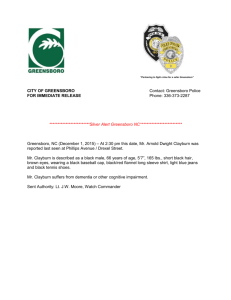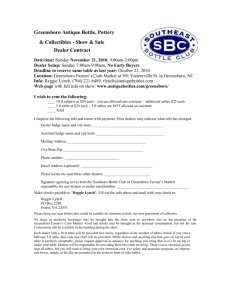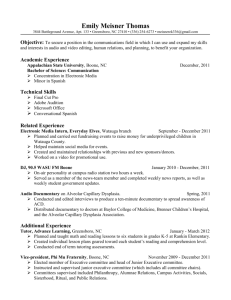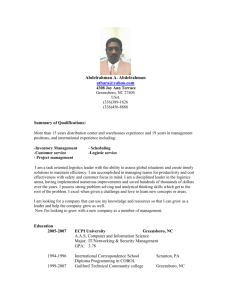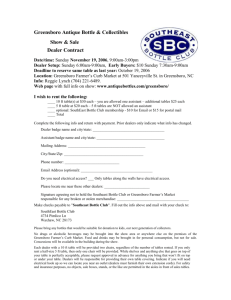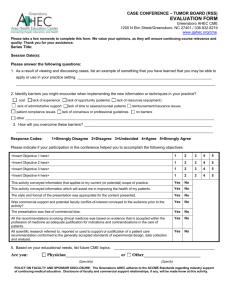Lewis Brandon, III - The Greensboro Truth and Reconciliation
advertisement
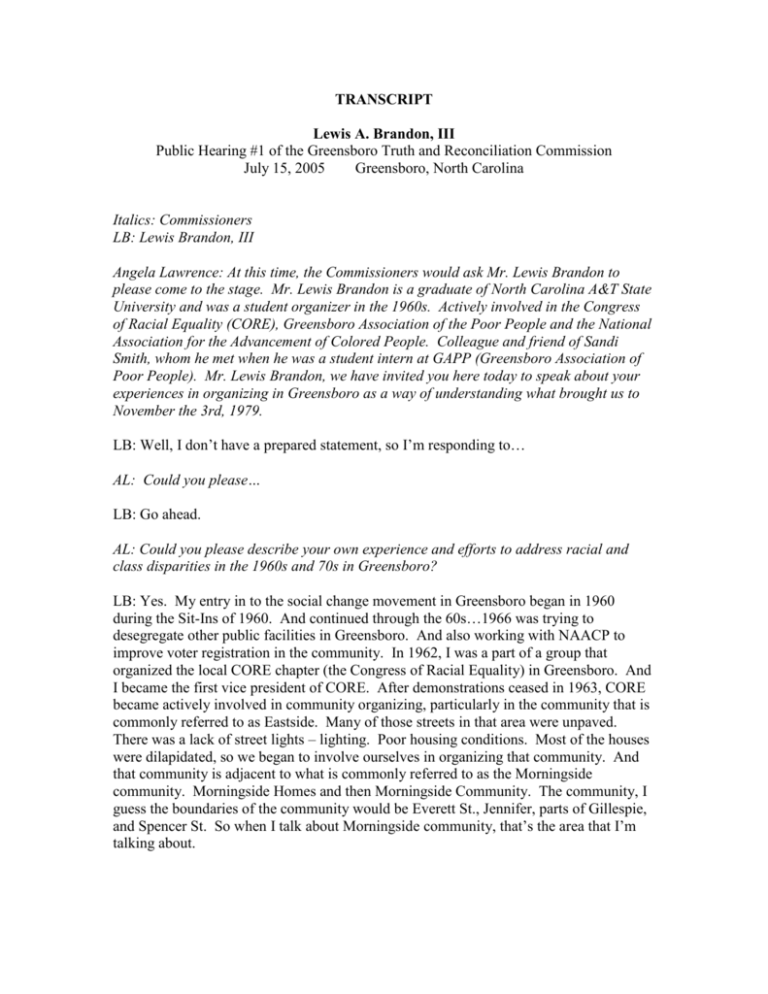
TRANSCRIPT Lewis A. Brandon, III Public Hearing #1 of the Greensboro Truth and Reconciliation Commission July 15, 2005 Greensboro, North Carolina Italics: Commissioners LB: Lewis Brandon, III Angela Lawrence: At this time, the Commissioners would ask Mr. Lewis Brandon to please come to the stage. Mr. Lewis Brandon is a graduate of North Carolina A&T State University and was a student organizer in the 1960s. Actively involved in the Congress of Racial Equality (CORE), Greensboro Association of the Poor People and the National Association for the Advancement of Colored People. Colleague and friend of Sandi Smith, whom he met when he was a student intern at GAPP (Greensboro Association of Poor People). Mr. Lewis Brandon, we have invited you here today to speak about your experiences in organizing in Greensboro as a way of understanding what brought us to November the 3rd, 1979. LB: Well, I don’t have a prepared statement, so I’m responding to… AL: Could you please… LB: Go ahead. AL: Could you please describe your own experience and efforts to address racial and class disparities in the 1960s and 70s in Greensboro? LB: Yes. My entry in to the social change movement in Greensboro began in 1960 during the Sit-Ins of 1960. And continued through the 60s…1966 was trying to desegregate other public facilities in Greensboro. And also working with NAACP to improve voter registration in the community. In 1962, I was a part of a group that organized the local CORE chapter (the Congress of Racial Equality) in Greensboro. And I became the first vice president of CORE. After demonstrations ceased in 1963, CORE became actively involved in community organizing, particularly in the community that is commonly referred to as Eastside. Many of those streets in that area were unpaved. There was a lack of street lights – lighting. Poor housing conditions. Most of the houses were dilapidated, so we began to involve ourselves in organizing that community. And that community is adjacent to what is commonly referred to as the Morningside community. Morningside Homes and then Morningside Community. The community, I guess the boundaries of the community would be Everett St., Jennifer, parts of Gillespie, and Spencer St. So when I talk about Morningside community, that’s the area that I’m talking about. 2 I left Greensboro in ’64 to go into the military. I served 2 years in the US Army. Returned to Greensboro in ’66 and enrolled in graduate school at A&T and became involved in some activities around campus to seek additional funds for the school. And I also, you know it is difficult for me to talk without naming names. You know, that is kind of a restraint that I’m not used to. But one of the demonstrations that I became involved in was demonstrations against ROTC program at A&T. The ROTC program was mandatory when I first arrived there. And there was an organized effort to make it voluntary. And so at that point, I became involved in that demonstration. And I met Nelson at that point. On the picket lines. And so things kind of evolved from that. I began to become involved again with activities with the NAACP, particularly with voter registration and some other activities that was going on in the community. There was a group called UNITE, UNIT rather…it was United Neighborhood Improvement Team, which consisted of organizations in the public housing and some other community organizations and that organization gave rise to, eventually gave rise to GAPP, the Greensboro Association of Poor People, which started with the work of 6 interns coming into Greensboro at the request of, or being sponsored by 12 business and professional members in the black community. And so up through the ‘70s, particularly the mid ‘70s, most of my work was through the Greensboro Association for Poor People and the Foundation for Community Development. AL: Okay. What was the response of the city power structure to these efforts? LB: Well, it depends on which effort you are talking about. If you go back to the early ‘60s. Immediately after the demonstrations. The City Fathers began to try to seek ways to curtail further student demonstrations. And that even occurred in 1963 when the mayor went to the governor and asked if official legislation could be enacted to prevent students from demonstrating. One other instance where particularly after the revolt, the A&T Dudley revolt in 1969, the city had the opportunity to do something very concrete about conditions and relationships. There was a block grant that was coming down vis a vis the Community Development Fund. And GAPP, along with some other organizations, pushed for the establishment of a satellite health system in one of the communities. We thought that people who needed to have a place where they could come and not have to go to the health department or other places. That something in the neighborhood would be very good for them. The city chose…and this was right after 1969…chose to, instead, to use those funds to rearm the police department. That was the response. And so they bought these large weapons that the officers were wearing on their hips. And then they had these large, these long rifles that they mounted inside the police cars so that…and this is largely to intimidate the black community because the police were comfortably riding through the black community with these mounted rifles. And the other funds were used on putting a fence around Green Hill Cemetery and doing some air conditioning at the Greensboro Historical Museum. But after all of the struggles up to that point, where the city had a chance to engage in bringing about some change, the city chose to do other things rather than trying to bring people together and really trying to build community. 3 AL: What was Sandi Smith’s involvement in these local issues? LB: I’m not sure when I first met Sandi. But I do know in 1972, as a student at Bennett, she was an intern at GAPP and worked with us on a number of issues that we were working on at that particular time – that we were heavily involved in. We were involved in housing, particularly along Gillespie St. There was an area called Horton’s Row. The realty company had these shotgun houses and you know the conditions were very dire. And so we were working there. There were a number of issues around welfare and educational issues. I know Sandi was very active on the picket line during the campaign against the North Carolina competency tests in the mid-‘70s AL: Okay, as it relates to the November 3rd, 1979 tragedy, can you speak specifically to the involvement of the Greensboro Association of Poor People? LB: In ’79? AL: In Morningside Homes, yeah. LB: Well, in ’79, GAPP had been demised. But leading up to ’79, there was a lot of involvement of GAPP. With the formation of GAPP, coming out of the work of the student interns, two of the GAPP board members were residents of Morningside Homes. YUBS, Youth United for Blackness, which was the student arm of GAPP, many of the students involved in that were also the students who were involved in the Dudley Revolt, lived in Morningside Homes. GAPP was involved…even though it didn’t endorse political candidates, it was involved in a lot of voter education work because we shared an office with the NAACP on Gorrell St. So, a lot of the work that we did, we did for the NAACP. Whenever there was a voter registration drive we were involved in that. The work took place in Morningside as well as other places. You know on election days, the calls would come in to the office for rides to the polls, so we would shuttle people back and forth to the polls. GAPP had three different offices. We first were on Gorrell St. and then we moved from there to Law St. and then in 1974 we had an office on Everitt St. right across from…the center…right across from Carver and Everitt St. I mean we were right there in front of the Center in Morningside Homes. We had a clothing bank and so many of the people in the community used the clothing bank. And so we were actually in the community in 1974 on Everitt St. AL: What steps had you taken to ensure that residents were prepared for the Death to the Klan march that was to begin in Morningside? LB: Say that again? AL: What steps were taken to get the consent or to help prepare the residents of Morningside? LB: Knowing the way the master…organizers worked and the person who was organizing this demonstration, it was his policy to always inform people about what he 4 was getting ready to do. I mean people in the black community knew what he was getting ready to do. In particular, there was a group of black professionals and people in the middle, who were middle class people, who always knew what the master organizer was doing. I mean he made the rounds. He went and talked to people and said to them exactly what it was that he was planning to do, so people knew. I mean that was the technique that he used then and he still uses today. AL: For people here who may not know who the master organizer is, could you please name him? LB: Nelson Johnson. AL: Okay, thank you. LB: I mean that’s the kind of person he was. You know…there will…you’re going to always…there were people like A.S. Webb who was the executive vice president of American Fedearl Savings and Loan. I mean, he knew. George Simkins knew. Cecil Bishop, who was the pastor of Trinity, I mean that’s what he did. He went around and talked with people and consulted with people. AL: Could you please explain the view you expressed in your statement that Greensboro is a city that projects an image of moderation while at the same time trying to avoid substantive reforms? LB: Yeah. I don’t know of any social change that occurred in this community without a struggle. I’ve been here since 1957 and this is a city that does not do things because it is the right thing to do. It does things because it’s forced to change. And when the city has had opportunities like after 1969 to do something, it went out and bought guns. You know, after the1960, it had an opportunity to do something and it decided to go to the governor to try to curtail the activities of students. But there are other incidents. Like in ’57, rather than desegregate the swimming pools it sold the swimming pools and got out of the swimming pool business. In ’58, when the school system was ordered to take two students in at Caldwell School, they moved all of the white students out, the white teachers out, and Caldwell School, which is over on Martin Luther King, became an all black school. This is how this city operates. After ’69 the civil rights commission came in and did a report and made recommendations found in the book “Trouble in Greensboro.” If you go back and look at what happened in ’69, I think it is “White perspectives, Black Perspectives,” they found the same conditions existed ten years later. That’s the Greensboro I know. Change doesn’t come because of the goodness of the people in the community. People have to struggle, people have to fight to get change in this community. AL: Can you speak to the issue of distrust between the black community and the police? LB: Well, you know, one would think that the police department is supposed to be working for the people. But that’s not the case and that hasn’t been my experience. That 5 even, I often refer to Greensboro as a mill town, even though the financial institution is dominant. But there is still that mentality that the police actually work for the mill bosses as opposed to working for the people. So here is the police department engaging themselves in activities of disrupting first amendment rights, people’s right to protest, people’s right to demonstrate, you know. Like for instance there was a demonstration, students had been out. It was Malcolm X’s birthday, people were honoring Malcolm X and they were walking back to campus and mysteriously…well the police say it was an accident…but they were tear gassed, you know. There are other instances where people were harassed. There is dis-information. In my case, I know there were things personally where police were trying to influence my employers, and in one case, prevented me from getting a job because they were going out and said that this communist was coming to work at the Community College here. But I mean it is that kind of thing. But the police is always, have always been involved in my experience in activities that they shouldn’t have been involved in. People being out on the picket line, that’s their…that’s their right and the police department should not be interfering with that right. And they’ve been engaged in that kind of activity. AL: Okay, before I open up the floor for other commissioners to ask you a question, I wanted to know if there is anything else you wanted to add today. LB: Just ask me some questions. AL: Just ask you some questions? Okay, well can I ask you, can you in your perspective sum up what brought us to November the 3rd, 1979? LB: I think it’s the unwillingness of this community to accept the view that people have a right to decent wages and to decent living conditions. And that because you know the city was unwilling to, to make changes people had to go out and struggle and still people are struggling. People were organizing to make sure that people got a decent take on life in this community and so that’s why people were out there. That is the thing that brought people to November 3, 1979, is the fact that there’s a constant struggle to change the conditions of people, and particularly poor people, in Greensboro. AL: Do other commissioners have any questions? MJ: Mr. Brandon, you mentioned that ROTC was mandatory when you went to college? Was that an institutional practice? LB: That was a practice at land grant schools. MJ: I’m sorry? LB: That was a practice at land grant schools. MJ: It was? Okay. 6 BW: I remember when East Market St. was widened; it was that many E. Market St. merchants were moved out as well as many housing units that were along there. Have you any reflection about any of that? LB: Yeah. You know GAPP was very involved in the struggle against redevelopment in that area in particularly Washington I and Washington 2 and East Market St. Many of the people who were living in those areas, even though the housing was substandard, ended up in public housing because one of the promises was that when new housing was built, the people would be able to move back into. They had the first choice of coming back into those neighborhoods. But the type of housing, the rezoning, was RS12, people were not able to afford those houses and so they ended up in public housing. Not only that, but merchants who serviced that community in particular A&T students were moved out of the crew, were closed down and there was no way that they could come back in because one of the things that they did was they rezoned the area from commercial to institutional. And so you couldn’t come back in because there was no commercial zoning in that area. An offshoot of GAPP was Uhuru. We formed the Uhuru corporation which was out entry into the arena of economic development. And we were looking to open a book store across from A&T’s campus. And we had leased space in the lodge building for that purpose. But we couldn’t get a license for the bookstore because bookstores could not operate in an institutional zone – an area that was zoned institutionally. And so the city of Greensboro, we went to them and tried to get a variance and they wouldn’t give it to us. BW: Do you have any idea why not? LB: Because of who we were. And some of the activities that we were involved in the organizing in Greensboro. BW: Was there a particular purpose for running the merchants off there? LB: I think so. I think that it’s sort of like the book store, people who want the business, you know. The people who ran us, Uhuru, out of business now are the people, Barnes and Noble and Borders have pushed the smaller independent bookstores out. People, you know, the whole idea is to make money and make profits and so if you don’t have black merchants as competition then you got all of the black business coming to you. That community was very self sufficient when I came here to Greensboro. I talk about this a lot…there are two cities, Greensboro and A&T. And I knew about Greensboro in Asheville because I read about a man named George Simkins...I read about two men: George Simkins and Charlie Herbin winning the tennis championship, the city tennis championship in 1955. And you know I was reading about it in the Asheville paper. This was the open, the Greensboro Open Tennis Championship. The next year the championship was moved to a country club so it was closed. Blacks weren’t allowed to participate. When black students were coming…wanted to go to band clinic or to the all star games…basketball, east and west all star games, they didn’t come to a place called Greensboro. They came to a place called A&T and so I had these two cities. And it wasn’t until the point that I bought my ticket to come to Greensboro that there was a 7 connection, but then when I got to Greensboro I found out that even though A&T was in Greensboro, it wasn’t of Greensboro, it was a separate city altogether. And so the business district around East Market St. was a part of A&T. BW: Do you think that the remaking of East Market St. signifies anything? LB: I’m not sure what you mean by remaking. I know that they have done streetscaping and all of that, but I’m not sure that replaced what was torn down and what was eliminated. Family businesses…there had been a tradition of family businesses in that area…actually there are only two businesses left in that area and they both are funeral homes. BW: So all the new stores that are going up on the opposite side of the streets probably are not family businesses? LB: And many of them will not be African American businesses. BW: Well, they weren’t before were they? LB: Yeah. That was the whole point. They were owned by black folk who employed other black folks. BW: But there were stores on East Lee St. and not on East Market St. that were not owned by African Americans? LB: Well, East Lee St. was kind of foreign to us because East Lee St. was a white area when I came to Greensboro. BW: Oh. Thank you. AL: Any more questions? PC: I have a question. Can you say something about the effect that November 3rd had on the various struggles and campaigns that you were involved in? LB: Yeah. It shut down a lot of the work in the community. There were people who were involved with us, particularly from the black middle class who kind of pulled away. And they were scared off by the dominant community. I don’t think it was until the KMart struggle that the community came together as we did in the 60s. I mean, people kept, what was happening in ’69 and 70s with all of the labor struggles that were not a part of Union organizing and union activity, but people who decided that they wanted better working conditions, better wages came together with the leadership, their own leadership, but also working with the black community ministers, middle class business professionals to forge a strong bond to push for changes. But all of that ceased and ended post-1979. Things were in disarray. And the only semblance of that type of unity in the black community surfaced around the K-Mart struggle. You had workers, you had 8 clergy, you had professional people all out there struggling for the workers at K-Mart. I hope that answers you. BP: I have another question for you, Mr. Brandon. There was a mention of mistrust between the police and the black community and I’m wondering, have you noticed any changes over the years? More particularly, what about present time? LB: I don’t think so. I think that people see the police department as not being a friend of the community, that they serve the interests of the power structure. You witness what happened with Darryl Howerton. He was a young man who was sick, who needed help. He was naked out on Phillips Avenue. Instead of the police calling in professional people to help gather him in, they shot him down. It is those kinds of incidents that keep occurring in our community and so people don’t trust the police. But also the police are interfering and disinformation, the spreading of rumors and character assassination; we know that to be true because we’ve been involved in some of it personally. AL: Well thank you Mr. Brandon for your wisdom and sharing your experience with the Commission. [applause]
